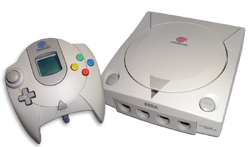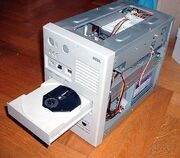Dreamcast (also known as DC and Sega Dreamcast) is a 128-bit game console created by SEGA Corporation. It was designed to compete with the Sony PlayStation 2, whose pre-release hype and promises hurt SEGA in the end. The Dreamcast is still comparable to the PS2 and GameCube, and can pull more/higher resolution textures than the PS2 can with it's more potent VRAM. It can pull theoretically 7 million polygons per second, fully shaded and textured, although no games ever attempted this, with the exception of Test Drive Le Mans running at 5 million PPS. Most Dreamcast games ran at 800,000 to one million PPS, especially PlayStation ports that didn't dare use the system's resources well.[1]

The SEGA Dreamcast System
There was also a prototype development kit version, but it is very hard to come by and little is known about it.

Dreamcast Development Kit
System Specifications[]
- CPU: Hitachi SH-4, 200MHz clock rate, 360 MIPS (millions of instructions per second), 1.4 GigaFLOPS (floating-point operations per second), 128-bit 3D calculations, 64-bit data bus, 800+ MBytes/second bus bandwidth
- Graphics Core: NEC PowerVRSG, 3 million polygons/second peak rendering rate (vastly underestimated as per SEGA tradition), Perspective-Correct Texture Mapping, Point, Bilinear, Trilinear and Anisotropic Mip-map filtering, Gouraud shading 32-bit z-buffer, Colored light sourcing, Full scene anti-aliasing Hardware-based Fog, Bump mapping, 24-bit color, Hardware-based texture compression, Shadow and Light volumes, Super sampling
- Memory: 16 MB main RAM, 8 MB video RAM, 2 MB sound RAM
- Resolution: 640x448.
- Colors: 16.7 million
- Sound: Yamaha Audio Core, 32-bit RISC CPU, DSP for real-time effects, 64 sound channels, Full 3D sound support, Hardware-based audio compression
- Dreamcast Control Pad: Digital and analog directional controls, Dual analog triggers, Virtual Memory System data save unit
- Expansion Options: Modem: 33.6kb per second transfer rate (56kb in U.S.) upgradeable to BBA (Broadband Adapter)
- Operating System: Customized Microsoft Windows CE and Sega operating system (developer's choice, OS-on-disc)
- Media: GD-ROM (Giga Disk-ROM) Drive - Maximum speed 12X 1.2GB capacity
- Console Dimensions: 7 7/16" X 7 11/16" X 3" , 190 mm (W) x 195 mm (H) x 78 mm (D)
- Weight: 4.4 pounds, 2.0 kg
- Release Date: November 20, 1998 (Japan), September 1999 (USA)
Credit Emulator-Zone.com for System Spec[2]
Online Games[]
This was one of the first consoles to go online via official support in games and hardware. Many games could be played in multiplayer over the phone line, or by the middle of 2001 with the replacement broadband adapter (supported high-speed games). Sadly most of the servers have shut down leaving only a small number of them still online.[3]
User Created Content[]
The Dreamcast system was one of the first that could boot CD-R's without any trouble, so many open source and public domain games and tools are available for download and can be played simply by burning and inserting an ordinary CD (with the proper burning and prepping procedure). This led to rampant piracy as well. Sega's last model Dreamcast (Revision 2, had a circle on the bottom with a 2 in it) cannot boot from burnt DC-bootable CD-R's at all.
Operating Systems[]
The Dreamcast is powerful enough to boot an entire OS, there is a port of Debian and NetBSD Linux among others.[4]
Browser[]
The commonly known user created web browser is XDP. It is capable of configuring your modem, connecting to alternate ISPs, loading websites via a Netscape interface, and even joining IRC channels among other things.[5]
Emulators and Games[]
There are several emulators that can play other platforms on the Dreamcast console, as well as some legal demos and free games.[6]

